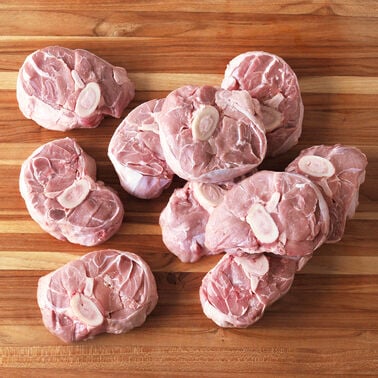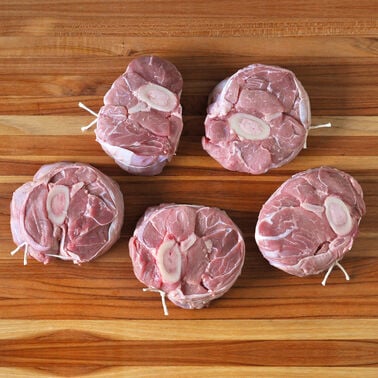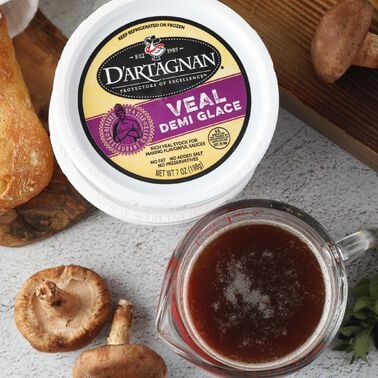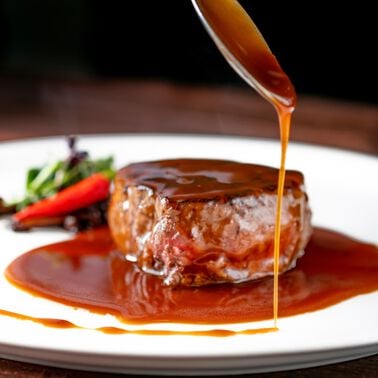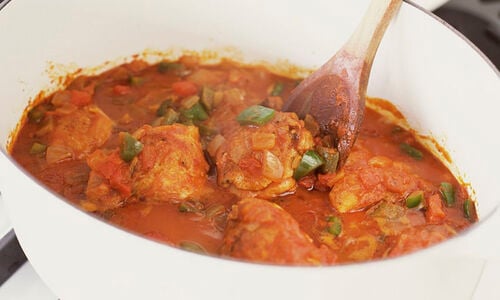Veal Osso Buco
- 6 pieces Veal Osso Buco
- 3 tablespoons coarse salt
- 3 tablespoons freshly-ground black pepper
- 2 cups all-purpose flour
- ½ cup olive oil, plus more as needed
- 3 tablespoons minced garlic
- 1 large onion, peeled, medium diced
- 2 large carrots, peeled, medium diced
- 3 ribs celery, medium diced
- 3-4 sprigs thyme
- 2 bay leaves
- 3 cups white wine
- 2 containers Veal Demi-Glace, dissolved in 2 quarts of water
- 2-3 quarts water, with a pinch of salt
- 1 medium celery root, peeled, medium diced, blanched
- 1 rutabaga, peeled, medium diced, blanched
- Preheat oven to 375 degrees F.
- Season the shanks with salt and pepper. Coat both sides with flour, shake off excess. Heat ½ cup olive oil in a thick bottom saute pan. Brown the shanks slowly in the pan over medium flame. When brown, place the shanks in a roasting pan that has at least 4 inch sides.
- Pour off the excess fat from the previously used saute pan. Place over low heat. Add ⅓ cup of olive oil and garlic, onion, carrots, thyme, and bay. Gently stir with a wooden spoon to caramelize the vegetables, about 5 to 10 minutes. Add the white wine and scrape the drippings from the bottom of the pan.
- Pour the wine and vegetable mixture over the veal shanks. Add just enough demi-glace mixture to barely cover. Cover the pan tightly with aluminum foil. Place in the oven and braise for about 2 hours.
- After about 1 hour of cooking, check to make sure the shanks are braising properly. The liquid should be slightly simmering. If it is too hot, reduce the heat.
- The osso buco is done when the meat pulls away from the bone. Remove the shanks from the oven and transfer from the roasting pan to a small baking pan. Keep warm by covering with foil. Set aside.
- Strain the contents of the roasting pan into a soup pot. Reserve the vegetables, set aside. Place the soup pot on the burner at medium heat. Skim the grease off frequently. Reduce the stock by half, about 15 to 20 minutes.
- While reducing the stock, bring the salted water to a boil in a large stock pot over medium heat. Add the celery root and rutabega. Cook until soft, about 6 minutes. Drain and set aside.
- Add the reserved vegetables, celery and rutabega to the reduced stock. Gently simmer at medium heat until hot, about 2 minutes. Season with salt and pepper to taste. Heat the osso bucco in the oven (if needed) about 10 minutes before serving. Serve with mashed potatoes and a generous ladle of sauce with vegetables.
Yes, beef or pork shanks can work as substitutes. The flavor will be slightly different, and cooking times may vary. Beef, for instance, might need a bit more braising time to become tender.
Veal demi-glace provides a deep, rich flavor that enhances the dish. If you don’t have it on hand, beef stock or a homemade reduction are alternatives, but the flavor profile may change a bit.
Flouring the veal shanks adds a light crust when browning, enhancing texture and taste. It also helps thicken the sauce during the braising process.
Yes, though red wine will deepen the color and flavor of the sauce, giving it a richer taste. White wine is traditionally used for a more delicate and balanced flavor in osso buco.
It’s important to make sure the shanks are gently braising. If the liquid is boiling too rapidly, it could dry out the meat or cause it to overcook. Adjust the heat as needed for a slow simmer.
Yukon gold truffle butter mashed potatoes and creamy polenta are perfect companions, as they complement the braised veal’s richness beautifully.
Yes! Osso buco is even better the next day, as the flavors meld beautifully. Just reheat slowly in the oven before serving for best results.
Yes, beef or pork shanks can work as substitutes. The flavor will be slightly different, and cooking times may vary. Beef, for instance, might need a bit more braising time to become tender.
Veal demi-glace provides a deep, rich flavor that enhances the dish. If you don’t have it on hand, beef stock or a homemade reduction are alternatives, but the flavor profile may change a bit.
Flouring the veal shanks adds a light crust when browning, enhancing texture and taste. It also helps thicken the sauce during the braising process.
Yes, though red wine will deepen the color and flavor of the sauce, giving it a richer taste. White wine is traditionally used for a more delicate and balanced flavor in osso buco.
It’s important to make sure the shanks are gently braising. If the liquid is boiling too rapidly, it could dry out the meat or cause it to overcook. Adjust the heat as needed for a slow simmer.
Yukon gold truffle butter mashed potatoes and creamy polenta are perfect companions, as they complement the braised veal’s richness beautifully.
Yes! Osso buco is even better the next day, as the flavors meld beautifully. Just reheat slowly in the oven before serving for best results.

